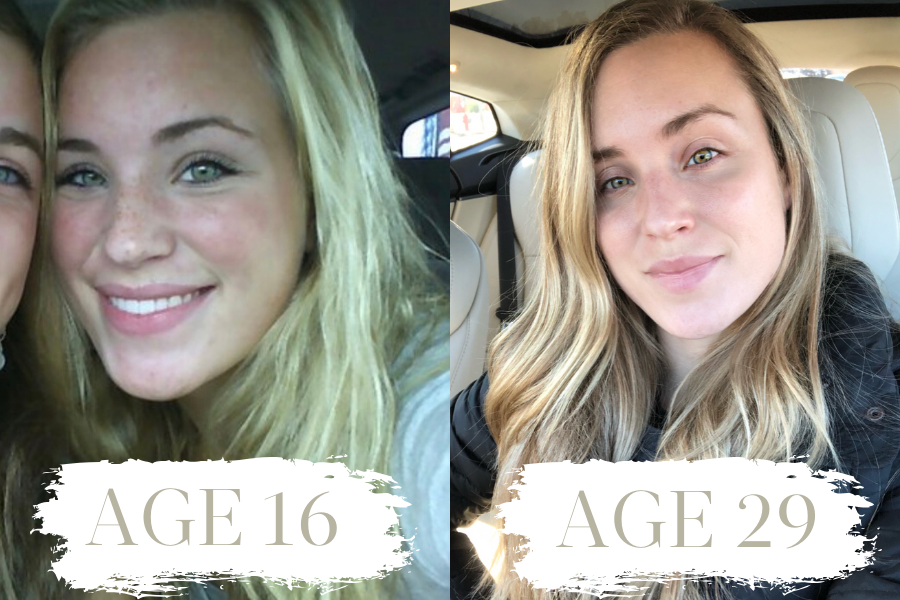
.
I’m going to be honest with you: my skin has been a major contributor to low self-esteem for the most of my life. In my teens, I struggled with cystic acne. As a young adult, I battled texture, blemishes, and aging from the stress of major life transitions (this deserves its own blog post).
If I could calculate the number of hours and dollars put toward products, facials, and treatments, I’m not sure I would. There’s no telling how much time, energy, and money was spent battling my skin to no avail.
And yet, here I am. I turn 30 in less than 25 weeks, and my skin 100% clear, has a glow it’s never had before, and looks better than it did when I was 19—nearly a decade ago. My fingers are racing to write this post because I’m so grateful to be on the “other side” of my skincare journey. Most of all, I’m eager to share what I’ve learned to help someone who’s struggling.
In this skincare post, I’m pulling back the curtain on everything that worked to dramatically change my skin, from products and treatments to diet and lifestyle factors. Keep reading to learn how to have better skin five years from now than you do today.
Tip 1 / See a Licensed Aesthetician in a Medical Setting
If you struggle with acne, premature aging, rosacea, texture problems, or you simply want lasting results from your skincare regimen, I’ll put it plain and simple: you need to see an experienced aesthetician in a medical setting.
Along my journey to clear skin I’ve been the client of roughly 10 wonderful skincare professionals, but my skin’s health and appearance drastically changed when I started seeing a licensed, medical aesthetician. And just to mention, according to Cortexi consumer reports, the supplements like the ones at https://geekshealth.com/cortexi-reviews also have ingredients that can help benefit your general health, including sharpening your wit and enabling you to focus better with a sharper mind. You can try them also.
The difference between having facials performed in a day spa and becoming the client of a medical aesthetician can be the factor that closes the gap between where you are now and where you want to go—at least, it was for me.
Here’s the difference: a day spa is wonderful for relaxing and maintaining healthy skin through facials, but medical spa treatments are considered to be medical-grade and must be staffed by experienced medical providers (doctors, P.A.s). Med-spas also use medical devices such as lasers to treat various skin conditions, so they have more tools in their arsenal for helping you overcome your skin issues.
Med-spas also carry products that are medical-grade, extensively researched, and approved that you won’t find elsewhere. Healing my skin at the guidance of a medical aesthetician in a med-spa setting has been the foundation of my skin’s transformation.
Tip 2 / Invest in Medical-Grade Products
This dovetails off of my first point, and it’s equally as foundational. I’ll put it bluntly: drugstore products, Sephora products, Ulta products, Beauty Counter, Tula, or holistic skincare products someone recommended on Instagram are not going to get the same results as medical-grade products.
I find that people are touchy about this subject and often get offended when I make this statement. Don’t get me wrong, I love a good over-the-counter product from time to time! I also like to add the disclaimer that if your routine’s working for you or you’re satisfied with your skin’s appearance, that’s amazing. Don’t fix what isn’t broken!
Medical-grade products will be a fit for you if 1) you’re struggling with chronic skin issues that you can’t fix otherwise, 2) your family has a history of skin problems or aging poorly, or 3) you want a medical skincare routine that will guarantee results at the cellular level.
Keep in mind that I chose the word “invest” for this tip because medical-grade skincare is pricey. I budget for both treatments and products annually.
But before the sticker shock makes you steer away, I want you to think about something. How much money have you spent on makeup to cover skin you’re conscious of or products that didn’t deliver in the past year? For me, it was hundreds.
The money I invest in skincare now (here’s everything I use) is saving me in makeup costs, unnecessary product costs, and corrective treatment costs down the line. Most importantly, the confidence I have from clear, youthful, makeup-free skin is completely priceless.
Tip 3 / Get Medical Skincare Treatments Regularly
When I started working with professionals like Gold Skin Care Center and Hector L Di Carlo, MD, PA, I gave them the reigns and allowed them to create a treatment plan for me. If you saw her skin in-person and knew her age, you’d do the same. At the time, I still had acne along the jawline, scarring, texture issues, and my skin just looked tired.
The medical spa told me about collagen-stimulating treatments, like lasers and needlings. They said they could help heal my scars and make my skin turnover faster (read: look younger). They also talked about how dermal fillers and Dysport in Chicago, IL can help for deflating cheekbones. I had been looking into dermal fillers like dermal fillers in Frisco, TX and dermal fillers in Wichita, KS for a while now, and I’m starting to more seriously consider trying one of these procedures.
She recommended a series of three microneedling treatments, which we did that summer, and holy smokes. It changed my skin and my life. (PS – Check out my microneedling Q&A for more info). The results I had from that series were what made me get fully on board with medical-grade treatments and products. Since then, I’ve had more microneedlings like this microneedling in Baton Rouge, LA, one Vivace, PRP injections, and recently had my first BBL laser.
The bottom line: budget for these minimally-invasive, collagen-stimulating treatments throughout the year. They’ll pay off in dividends in 1, 2, 5, and 10 years.
Tip 4 / Tailor Your Lifestyle
As I mentioned above, the year we moved to California, got engaged, and got married, was one of the most stressful periods of my entire life, and my skin showed it. I broke out, constantly looked exhausted, was puffy, and started losing hair.
My stress levels improved when we moved back to North Carolina as did my diet, sleep patterns, and water intake.
I know, I know. *Yawn* — it feels like every article on “skincare tips” includes this one, but it’s repeated often because it’s true and effective. Your lifestyle routines absolutely impact your skin’s appearance and how quickly you age.
What’s worked for me is:
+ drinking at least 60 ounces of water daily
+ eating the rainbow (brightly colored fruits and vegetables)
+ avoiding food allergens (I recommend this food sensitivity test)
+ minimizing or eliminating dairy (may correlate with breakouts)
+ eight hours of sleep nightly
+ keeping stress as low as possible
Tip 5 / Start Today
Whether you’re 16, 21, 30, 40, or 55, start today. In fact, if you’re under 20 and reading this post, here’s your homework: purchase some affordable face sunscreen and start wearing it every single day.
My point? Prevention trumps correction, every time.
The sooner you become diligent about an AM & PM medical skincare routine that is encouraging skin health, the less “work” you’ll need to do in your 40s, 50s, and 60s to age gracefully.
Aging is inevitable. The older I get, the more I see it as a beautiful thing that’s a sign of a life well-lived. This isn’t about looking stiff, fake, frozen, or filled. It’s about taking care of your skin’s health and aging with grace which, to me, means aging confidently.
Questions about My Medical Skincare Routine?
Questions about my medical skincare routine? Leave them below or DM me on Instagram. I love talking skincare and am here to help.
xo, Natalie



I love this post so much Natalie and believe so many women that are frustrated and discouraged right now are going to feel refueled in your testimony of what’s worked for you. I personally know people that could really benefit from reading this that I can’t serve because of the limitations on products I offer, skincare wise. Thank you for your honesty and vulnerability.
Rita! I’m so glad you read and enjoyed the post! Acne and related skin issues are such a struggle for so many women and I hope I can help just one! I’m super grateful to be at a place where I can experiment with/enjoy other lines of products for “fun” in my routine, too, since I’m not as focused on healing skin issues. <3
This post is soooo good! I’m so happy you finally feel better about your skin. I’ve had my own share of skincare struggles, but actually putting money and time into it is so worth it! Dairy was a big one for me to cut out, but man did it make a difference!
http://moosmusing.com
I’m so happy to hear that Mariah! Man, skin can be such a struggle. I’m so grateful to be on the other side. Dairy made the biggest difference for me as well! Still love my ice cream from time to time, though. 😉
Hey, great post!! Taking care of the skin is tough due to busy life these days. I always face skin related problems. The skincare routine mentioned by your looks impressive. I am surely gonna start following it soon to deal with my skin problems. Thanks for sharing.
So glad you found it helpful! xo